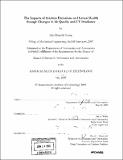| dc.contributor.advisor | Ian A. Waitz. | en_US |
| dc.contributor.author | Brunelle-Yeung, Elza | en_US |
| dc.contributor.other | Massachusetts Institute of Technology. Dept. of Aeronautics and Astronautics. | en_US |
| dc.date.accessioned | 2010-01-07T20:59:57Z | |
| dc.date.available | 2010-01-07T20:59:57Z | |
| dc.date.copyright | 2009 | en_US |
| dc.date.issued | 2009 | en_US |
| dc.identifier.uri | http://hdl.handle.net/1721.1/50606 | |
| dc.description | Thesis (S.M.)--Massachusetts Institute of Technology, Dept. of Aeronautics and Astronautics, 2009. | en_US |
| dc.description | Includes bibliographical references (leaves 142-148). | en_US |
| dc.description.abstract | World-wide demand for air transportation is rising steadily. The air transportation network may be limited by aviation's growing environmental impacts. These impacts take the form of climate impacts, noise impacts, and health impacts, the latter of which are addressed in this thesis. Aircraft emissions released into the atmosphere have an impact on human health. In the context of assessing the environmental impacts of aviation-related policies, costs and benefits on human health must be considered. Two different models were developed as tools to assess the impacts of aircraft emissions on human health. The first model estimates the changes in skin cancer incidences and mortalities due to changes in ozone column caused by aircraft NO, emissions. The second model estimates changes in health endpoits related to changes in ambient concentrations of particulate matter (PM25) by estimating changes in elemental carbon, primary and secondary organic PM, secondary sulfates, and secondary nitrates. The air quality model discussed herein is the second iteration in the development of a response surface model (RSM) based on a set of 25 simulations done with the Community Multiscale Air Quality model (CMAQ), a more complex atmospheric chemistry model. The increase in adult premature mortalities in the U.S. caused by air quality impacts of aviation emissions in year 2005 is estimated at 210 deaths per year (90% confidence interval: 130 - 340). This considers only those emissions that occur below 3000 feet above ground level as is consistent with current regulatory practice for aviation. | en_US |
| dc.description.abstract | (cont.) The monetized value of the mortality and morbidity effects using RSM v2 outputs is estimated at $1.4 billion in year 2000 US dollars (90% confidence interval: $550 million - $2.8 billion). Of these total impacts, 4 % are found to stem from emissions of volatile organic compounds and volatile particulate matter from organics, another 12 % from emissions of sulfur dioxide and volatile particulate matter from sulfur, 70 % from nitrogen oxide emissions, and 14% from non-volatile particulate matter emissions The net benefit from subsonic aircraft NOx in year 2002 on nonmelanoma skin cancer incidence and associated mortality in the U.S. is estimated at $130 M (90 % confidence interval : $68 - $220 M) in 2000 dollars. This corresponds to the prevention of approximately 6,200 new basal cell carcinoma cases (BCC) (90 % confidence interval: 3,800 - 9,100), 2,900 new squamous cell carcinoma cases (SCC) (90 % confidence interval: 1,700 - 4,200), and 20 nonmelanoma skin cancer (NMSC) premature mortalities (90 % CI : 13 - 28). The monetary benefits due to the prevention of 20 cases of premature mortality represent 96 % of total skin cancer benefits. | en_US |
| dc.description.statementofresponsibility | by Elza Brunelle-Yeung. | en_US |
| dc.format.extent | 148 leaves | en_US |
| dc.language.iso | eng | en_US |
| dc.publisher | Massachusetts Institute of Technology | en_US |
| dc.rights | M.I.T. theses are protected by
copyright. They may be viewed from this source for any purpose, but
reproduction or distribution in any format is prohibited without written
permission. See provided URL for inquiries about permission. | en_US |
| dc.rights.uri | http://dspace.mit.edu/handle/1721.1/7582 | en_US |
| dc.subject | Aeronautics and Astronautics. | en_US |
| dc.title | The impacts of aviation emissions on human health through changes in air quality and UV irradiance | en_US |
| dc.type | Thesis | en_US |
| dc.description.degree | S.M. | en_US |
| dc.contributor.department | Massachusetts Institute of Technology. Department of Aeronautics and Astronautics | |
| dc.identifier.oclc | 466135264 | en_US |
